The Mike Toole Show
Back to School
by Michael Toole,
I've heard a number of fans in my age group-- you know, the old farts with mortgages, kids, and car payments (note: I have none of these)-- complain to me that they've gotten kind of weary of anime that takes place in high school. I get the picture; as you get older, it gets harder to relate to the young protagonists of so many anime series. Plus, it just gets monotonous after a while, right? But every season's offering of schoolyard hjinks, be it Kids on the Slope or High School DxD, is also oddly comforting. High school is almost twenty years behind me, but I still remember those days perfectly well.
If you watch anime, what does high school mean? It means walking to school with pals. or taking the bike, or the bus. It means uniforms and after-school clubs. It means dozing in class, or getting caught peeking at someone cute. It means cramming the night before exams and making flash cards. It means the school bell and the sliding of the gate always sounding kinda the same, whether the school's in Hiroshima or Sapporo. It means field trips. It means the school festival. It means cicadas in the summer, and gentle snowfall in the winter. See, I dig that; there's a vocabulary there. Every school comes from the same line of garage kits, and the pieces all magically fit together.

But that's kind of idyllic, isn't it? Yeah, anime's like that sometimes. It's sweet and nostalgic, bathed in afternoon sunshine. When real life matches that imagery, it's pretty great. But for many of us, high school was also about being the poor kid in class. It was about failing grades and peer pressure. It was about bullying, and rejection. It was about standoffish cliques and indifferent teachers. It was about feeling like a fool no matter how you tried to dress or carry yourself. It was about being the “weird” kid, and not being able to shake that mojo for years.
Anime isn't usually about that second part, not really, but we've gotten two pretty good examples of it this year. The first one is a contentious title, a critical darling that much of anime fandom seems to have spurned for its harsh visuals. My ANN colleagues gave it high marks, but its streaming broadcast tumbled down the depth chart on Crunchyroll, outranked by shows from years ago, and in Japan the home video version was hobbled by delays and barely made it into four figures. I'm talking about Flowers of Evil. You know, the show that nerds complain looks like this:
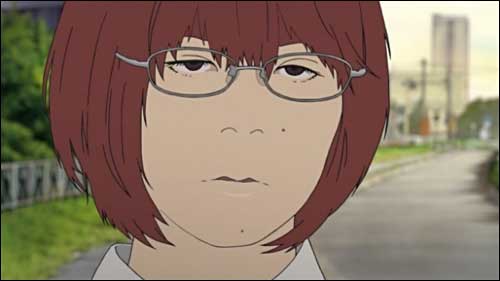
When honestly, it's just as liable to look like this:

Still, this 13-episode series, the product of Studio Zexcs and director Hiroshi Nagahama, takes a visual approach that is strangely and magnificently different from typical anime studio work: it employs rotoscoping, the practice of drawing animation directly over live-action footage. In fairness, a lot of shows employ a touch here and there-- that great band-jam stuff from Kids on the Slope utilizes the technique. If you grew up watching the many agreeable stock footage-fests from Filmation, fare like He-Man and the Masters of the Universe, Flash Gordon, and that weird old Star Trek cartoon, they also used a heck of a lot of rotoscoping. It's not a particularly exotic technique, it's just tricky to employ effectively. Consequently, most animators stay away from it. Director Nagahama doesn't have this problem, using this hyper-realistic approach to turn a ragged Gunma prefecture suburb into a place of isolation and alienation.
I think a lot of us were a little like Takao Kasuga as teenagers. He starts off with a few pals, but is a quiet kid. He doesn't like the dirty old town he lives in. He fancies himself a deep thinker, and tries to reinforce this idea by reading poems from Baudelaire's Flowers of Evil. His relationship with his parents is cordial, but a bit strained. (I do not like Kasuga's mom, who frets over him because “he's been reading too many books.” There's no such thing as too many books, SHUT UP MOM.) He struggles with the famous French poet's work, but latches on to Baudelaire's devotion to his mistress, his “muse” Jeanne Duval. Kasuga thinks he has a muse, too. She's pretty, she's popular, and her name is Nanako Saeki. So one day, he does something stupid - he steals something of hers, and his life slowly begins to unravel as a consequence.
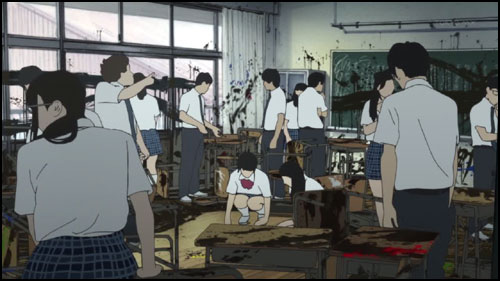
One thing the director (and by proxy, the original manga artist, Shuzo Oshimi) understands is fear. Monsters aren't scary; after all, they don't exist. Death isn't scary, because it's inevitable. A truly terrifying moment is when Kasuga enters the classroom one morning; like every other morning, his classmates are abuzz with noise and gossip. But when the class notices his arrival, the talking abruptly stops. Chairs scrape the floor raspily, as half of the class turns to stare at him nakedly, and the other half just as deliberately looks away. Why are they doing this? To Kasuga, it's completely unclear. This scene unfolds several times in Flowers of Evil, and it's always fucking terrifying.
In spite of his fuckup, Kasuga actually connects with Saeki, who's impressed with the way he reaches right past her looks and popularity; he seems to want her to read books, and to create an intellectual connection with him. But he never gets close enough-- his flaws and missteps are tracked ruthlessly by Sawa Nakamura, the class weirdo, whose rough prettiness is jarringly offset by her openly belligerent attitude towards her classmates and teachers. We laugh at Haruhi Suzumiya, who sniffs at her boring life and hectors her hapless club members, but Nakamura is Haruhi in real life, a girl who's nakedly disgusted with the world around her. She knows damn well that the best she can hope for is graduating high school, going to a third-rate college, and getting an OL job at the Subaru factory over in Ota, and so she dreams of escape, of rebellion, of painting the school black and setting it on fire. She saw what Kasuga did, and so she has a crumb of power over him; she clings to it, desperately.
So yeah, Flowers of Evil really approaches high school from a different angle, doesn't it? Kasuga slowly becomes convinced he's a terrible person, and egged on by Nakamura, acts out in more and more extreme ways. Nakamura howls her frequent threats and insults a little too loudly, as if she herself isn't quite convinced of her own feelings. Saeki just isn't strong enough to help either of them. The pair have no choice but to just keep on walking down never-ending streets, their school and home lives sources of unceasing anxiety.
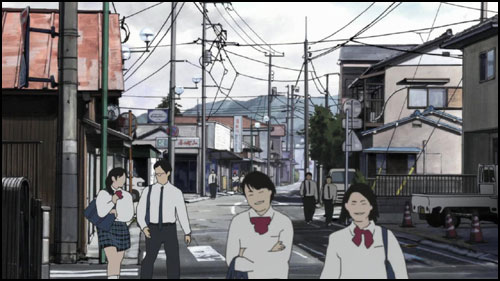
I'm not surprised that a lot of fans haven't embraced Flowers of Evil. It's got an aesthetic that is not only at odds with the look of the original manga, but also the look and feel of TV anime in general. As much as I like the look of the show, I still laugh at pictures like the above one, which sums up the limitations in Nagahama's visual approach nicely. The show burns slowly, which makes great sense to me; to Kasuga, his life seems staid and empty, so the pacing should be languid. Ultimately, Flowers of Evil is sometimes very hard to watch, and not just because it's stark and ugly. I'm looking forward to watching it again, when the blu-rays arrive.
Flowers of Evil is notable for taking a very un-anime approach, but there's an even newer series that takes a similar idea, and starts at what feels like the absolute opposite end of the spectrum, and that's Watamote. The title is a portmanteau that's short for Watashi ga Motenai no wa dō Kangaetemo Omaera ga Warui! or No Matter How I Look at It, It's You Guys' Fault I'm Not Popular!, one of those titles that's so long and awkward that I had to double-check to make sure it wasn't based on a light novel series. It's not; like Flowers of Evil, Watamote is based on manga.
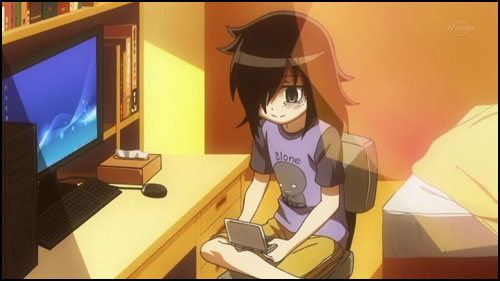
In the case of Flowers of Evil, we're meant to empathize with Kasuga, or at least pity him. This isn't really the case for Tomoko Kuroki, Watamote's protagonist. She's entering high school, and a fairly pleasant junior high life plus a whole summer of binging on high school dating sims has Tomoko convinced that she's got high school figured out. Obviously, she's in for a hell of a shock; she discovers that high school isn't that easy, and the mere idea of talking to her new, unfamiliar classmates fills her with dread. As her first semester progresses and her classmates make friends and start dating while she sits silently in the back, her inner monologues turn spiteful; she's better than those shallow bitches!
This would be an intriguing basis for a series if Tomoko had any redeeming qualities, but that's the hook of Watamote-- she really doesn't. Tomoko is hugely, hilariously unsympathetic, the anime answer to Welcome to the Dollhouse’s Dawn Weiner. She avoids socialization almost intrinsically, gleefully playing the role of a shut-in. She's short, scrawny, and has bad posture. Her skin is pallid from weeks spent indoors, playing dating sims. Her hair is limp and greasy, and her eyes have seemingly permanent bags under them, thanks to marathon gaming sessions. Her little brother, younger by a year, has the same baked-in scowl, but he's a little more grounded, a socially active kid who plays soccer. Obviously, she resents the hell out of him for this.
Watamote seems a bit less polarizing than Flowers of Evil; both titles are held in North America by Sentai Filmworks, and the former has been winning Sentai's facebook poll consistently since it started airing. In spite of that, I still have pals on twitter who've dropped it, complaining that the series just spends too much time mocking Tomoko. “Isn't this girl's crippling social anxiety hilarious?!” the show says to them. They've got a point; Tomoko's pathological shyness and naivety is used to set up broad jokes, but at times Watamote is just as tough to watch as Flowers of Evil, and for similar reasons. It shows us a high school life that, instead of being about eating lunch with pals and planning for the school festival, is simply a carefully regimented series of unpleasant encounters with nasty, inscrutable people.
But unlike Flowers of Evil's Kasuga, who starts off with a sort of gawky, awkward charm, Tomoko manages to bring a lot of grief down on herself. She agonizes over spending time with Yuu, her one best pal from junior high, but still broods over the fact that her friend now has good looks and a boyfriend. She gets revenge on her well-adjusted brother by heaping chores on him, and when she encounters a neighborhood boy who actually seems to get that she's a quiet, awkward girl, she still ends up scaring the shit out of him. She's sort of a pint-sized Ignatius P. Reilly, someone who's simply out of step with the world and takes her revenge by being as weird and abrasive as possible.
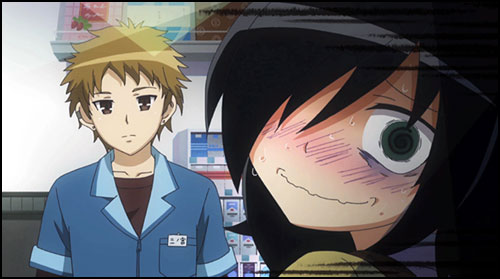
But for all of her faceplants, Tomoko manages to be oddly endearing at times. Sure, maybe she barely said a word to any of her classmates in 3 months, but don't worry guys, she's this close to figuring it all out! There's a weary familiarity to her situations, whether they involve playing a dumb card game with much younger kids and cheating at it anyway, or stumbling awkwardly into Starbucks, ordering a fancy coffee that cool people drink, and spilling the whole thing all the hell over herself. Her life is fraught with missteps and loneliness, but her mistakes and conflicts are more common than Kasuga and Nakamura's, so maybe there's a reason for her moments of boundless, misplaced optimism.
The jury's still out on Watamote, which wraps up its broadcast in a couple of weeks, but Tomoko would have to execute the mother of all pratfalls to screw it up. The franchise is still on an upward trajectory; a series of 150-page short manga books for junior high kids is due in the fall courtesy of Yen Press. Tomoko might not be popular with her classmates, but something tells me she's going to do just fine at bookstores. The same is true of Flowers of Evil, actually-- it hasn't set the anime world ablaze, but Oshimi's manga has become a solid and sustained hit for publisher Vertical, at least partly on the strength of the animated series.
So there's two current anime and manga titles that take a pretty different approach to high school. I think my favorite high school anime is still Kare Kano, though. I'm fond of its protagonists, Yukino and Soichiro, who are good kids in spite of their sometimes tough circumstances, and I appreciate the way director Hideaki Anno reinforces the story and characters with persistent, occasionally photorealistic imagery of the school; he eventually left the series, but those bits of Kare Kano, particularly the opening and ending, really stuck with me. Anno was right to populate the ending roll with restless tracking shots of high school corridors.

If you've visited Anime Boston, you've probably noticed that the convention staff enjoys going all-out with their annual theme, whether it be music, colonial times, or in this year's case, yokai and monsters. Elaborate displays and dioramas are constructed, the program book and website and branding are tailored to the theme, and the mascots dress up to suit the occasion. Several years back, one of the theme proposals for Anime Boston was simply “school”-- but a number of the staff balked at the idea. Some of these objections seemed obvious and well-reasoned-- where does the theme begin and end? Would the con do a high school motif, or college, since Boston is such a college town? But other staffers just didn't want to be reminded of high school, because for them, it sucked. It bummed me out to hear of this, not because I loved the idea of the school theme (it seemed fairly boring-- and I think AB went with “under the sea” instead), but because I had a pretty OK time in high school, and wish others did as well. If you're in high school now, I hope it's working out for you.
With that sentiment in mind, readers, do you want more stories like Flowers of Evil and Watamote, or do you prefer fare like Nichijou and The Daily Lives of High School Boys? Is there hope to be gleaned from Kasuga's despair? Is there any beauty in Tomoko's ugliness? What's your favorite high school anime? Sound off in the comments!
discuss this in the forum (52 posts) |